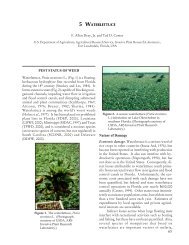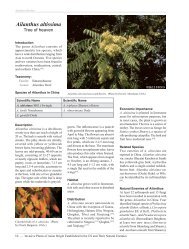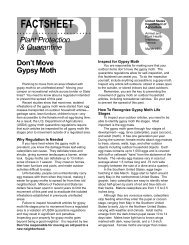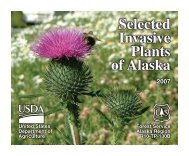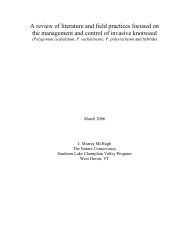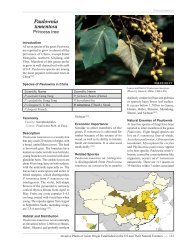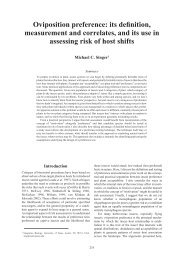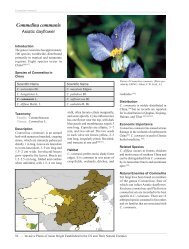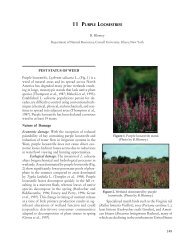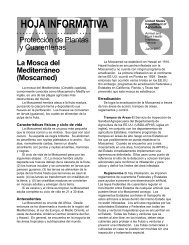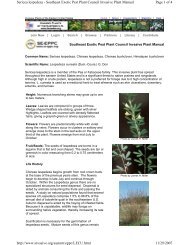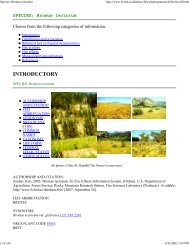A Guide to the Control and Management of Invasive Phragmites [PDF]
A Guide to the Control and Management of Invasive Phragmites [PDF]
A Guide to the Control and Management of Invasive Phragmites [PDF]
Create successful ePaper yourself
Turn your PDF publications into a flip-book with our unique Google optimized e-Paper software.
underst<strong>and</strong>ing phragmites<br />
control methods<br />
recommended management strategies<br />
fur<strong>the</strong>r information<br />
part 1<br />
part 2<br />
part 3<br />
part 4<br />
13<br />
-Herbicides-<br />
Consult <strong>the</strong> Michigan Department <strong>of</strong><br />
Environmental Quality (MDEQ)<br />
website at http://www.michigan.<br />
gov/deqinl<strong>and</strong>lakes or contact <strong>the</strong><br />
MDEQ Environmental Assistance<br />
Center (EAC) at 1-800-662-9278<br />
for more information about Aquatic<br />
Nuisance <strong>Control</strong> Permits. Contact<br />
local municipal <strong>of</strong>fices for information<br />
on city or <strong>to</strong>wnship requirements.<br />
gallon <strong>of</strong> imazapyr can be significantly<br />
higher than glyphosate, results from<br />
recent studies suggest that imazapyr used<br />
alone or in combination with glyphosate<br />
can control phragmites for a longer<br />
period <strong>of</strong> time (Getsinger et al., 2007).<br />
In most cases, herbicides should be used<br />
in conjunction with burning or mechanical<br />
methods, <strong>and</strong> reapplied in subsequent<br />
years <strong>to</strong> spot-treat individual<br />
plants or patches <strong>of</strong> plants that were not<br />
eliminated completely in <strong>the</strong> first application.<br />
Numerous methods may be used <strong>to</strong> apply<br />
<strong>the</strong>se herbicides depending on <strong>the</strong> size <strong>of</strong><br />
<strong>the</strong> phragmites st<strong>and</strong> <strong>and</strong> existing site<br />
conditions, as identified in Table 2.<br />
Application rates for low-volume spot<br />
treatment methods, such as injecting<br />
stems, h<strong>and</strong> swiping, wicks <strong>and</strong> backpack<br />
spraying, are calculated by percent <strong>of</strong><br />
solution (e.g., 2 ounces <strong>of</strong> herbicide in 1<br />
gallon <strong>of</strong> water yields a 1.5-percent solution).<br />
Application rates for high-volume<br />
treatment methods, such as boom<br />
sprayers, h<strong>and</strong> gun <strong>and</strong> aerial applications,<br />
are calculated on a per-acre rate.<br />
To ensure <strong>the</strong> herbicide is taken up by<br />
<strong>the</strong> plants, a state-approved nonionic<br />
surfactant must be used in conjunction<br />
with <strong>the</strong> herbicide(s) at <strong>the</strong> rate recommended<br />
on <strong>the</strong> label. Spray should be<br />
applied <strong>to</strong> wet <strong>the</strong> leaves <strong>and</strong>, when present,<br />
<strong>the</strong> flower plumes <strong>of</strong> <strong>the</strong> target<br />
plants. Excessive application, such that<br />
<strong>the</strong> chemicals are dripping <strong>of</strong>f <strong>the</strong> plants,<br />
should be avoided because it is more<br />
costly, can cause increased injury <strong>to</strong><br />
desirable nontarget species <strong>and</strong> <strong>of</strong>ten<br />
decreases <strong>the</strong> success <strong>of</strong> control. Visual<br />
effects, such as browning or wi<strong>the</strong>ring <strong>of</strong><br />
<strong>the</strong> plants, may not occur for several<br />
weeks. If <strong>the</strong> herbicide is applied close <strong>to</strong><br />
<strong>the</strong> first killing frost, symp<strong>to</strong>ms may not<br />
have time <strong>to</strong> appear before <strong>the</strong> plant dies<br />
back for <strong>the</strong> year. In this case, control<br />
effectiveness may not be determined<br />
until <strong>the</strong> following growing season.<br />
When using herbicides, always read <strong>and</strong><br />
follow directions on <strong>the</strong> manufacturer’s<br />
label. These directions must be followed<br />
in order <strong>to</strong> achieve legal, safe <strong>and</strong> effective<br />
treatment <strong>of</strong> phragmites. Only<br />
trained individuals should apply herbicides.<br />
Pesticide use certification, which<br />
can be obtained in Michigan through <strong>the</strong><br />
Department <strong>of</strong> Agriculture, is required<br />
prior <strong>to</strong> <strong>the</strong> use <strong>of</strong> imazapyr <strong>and</strong> recommended<br />
prior <strong>to</strong> <strong>the</strong> use <strong>of</strong> glyphosate.<br />
Permits are required in Michigan when<br />
applying herbicide <strong>to</strong> phragmites in<br />
st<strong>and</strong>ing water or below <strong>the</strong> ordinary<br />
high-water mark <strong>of</strong> <strong>the</strong> Great Lakes <strong>and</strong><br />
Lake St. Clair.


![A Guide to the Control and Management of Invasive Phragmites [PDF]](https://img.yumpu.com/27321025/18/500x640/a-guide-to-the-control-and-management-of-invasive-phragmites-pdf.jpg)

